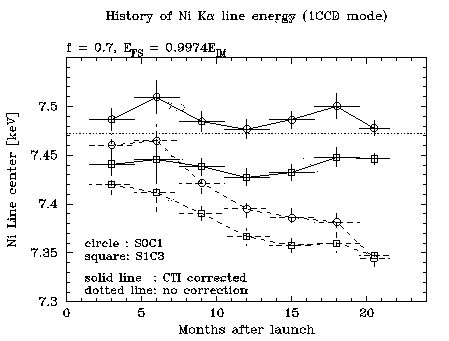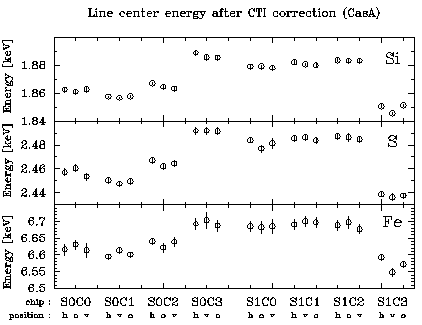Calibration Status of 4-CCD Mode Data
The SIS team is continuing to improve the spectral calibration of the instruments, and recently discovered several important effects that users of 4-CCD mode should be aware of.
(1) Secular gain change
SIS team has provided a preliminary calibration for the secular gain change, which is used by sispi, an FTOOL to populate the PI columns of the SIS event files. A study of the Ni line (in the detector background) shows, however, that the secular gain change is dependent on CCD clocking mode. The current calibration file (sisph2pi.fits) is applicable to 1-CCD mode data, while for the 4-CCD mode data, no secular change is apparent at this stage, at least in the Ni line data (see figures below).


Guest observers who have 4-CCD mode data are invited to try running:
example% sispi launch=yes Input ASCA SIS science file name[@ft.list] test_s0.evt Input SIS gain/CTI history file name[/ftools/SUN/release/refdata/sisph2pi.fits]This "launch=yes" option tells the software that the gain values at launch should be assumed, rather than those `appropriate' for the time of observation. Sispi will then adjust the relative gains of the chips and produce a uniform PI scale but will not apply secular gain correction. This does not require any additional software or calibration files; existing ones already have the capability.
However, please be warned that the apparent lack of secular gain change in 4-CCD mode is probably the result of 2 competing effects cancelling each other, when Ni lin data are collected from all over the chips. You may well see position dependence in line energies after the above procedure. Moreover, see point (2) below.
(2) Chip-to-chip variation of gain
The current calibration of relative gains among the 8 CCD chips is based on observations of the SNR W49B, which were unfortunately taken in a mixture of 1, 2 and 4-CCD modes. As a result, the relative fain calibration was not as accurate as we hoped. We believe the S0C1 gain to be approximately correct; S1C3 is ~0.5% off. The difference between the chip with the smallest and largest `gain' is 2% at present.

Line energies measured at 3 positions on each of 8 CCD chips.
(3) Secular degradation in spectral resolution
The spectral resolution is degrading in 4-CCD mode, presumably due to radiation damage (although the details are being studied). It may be possible to recover (close to) the original resolution, if a large amount of time is spent on calibration observations and software development necessary to carry out the correction. The SIS team is studying various options. Please note that current versions of software (sispi and the response builder) do not correct for any changes in spectral resolution.
Calibration Status of 2-CCD Mode Data
Calibration of 2-CCD mode data is in progress; SIS data in this mode are expected to display secular changes between those of 1-CCD and 4-CCD mode, but this has not been quantified yet. The result of the on-going effort will be reported later.
If you have any questions concerning ASCA, visit our Feedback form.

